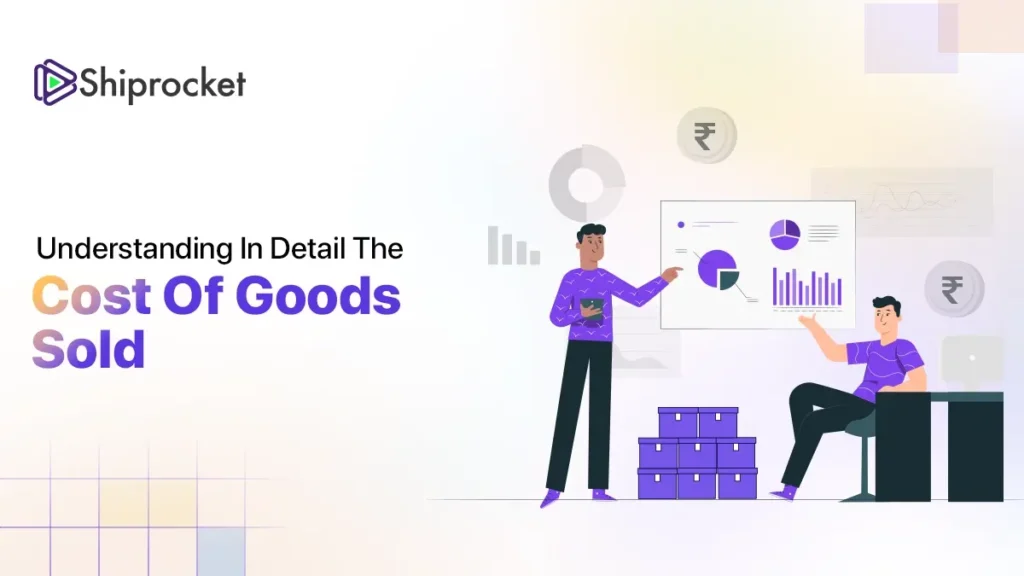- Overview of Cost of Goods Sold
- Examples Demonstrating COGS
- Elements Included in COGS
- Calculation of COGS
- Significance of COGS
- Constraints of COGS
- Impact of Inventory on COGS
- COGS Accounting Techniques
- COGS in Business Metrics
- Enhancing Profitability with COGS
- Companies Not Eligible for COGS Deduction
- How Do COGS Differ From Cost of Revenue, Operating Expenses, and Cost of Sales?
- Conclusion
If you are running a business, then you must know the cost of goods sold (COGS). This parameter is a big deal for any retailer because it plays a critical role in determining whether you’re raking in profits or barely scraping by.
As a business owner, you must have an understanding of how COGS works and how it affects your bottom line. It’s not just an accounting term – it’s the key to understanding your business’s financial health.
You can use your COGS knowledge to make smarter decisions and boost your business in the long run.

Overview of Cost of Goods Sold
COGS is all the money you spend to make or buy the products you’re selling. This is a simple idea, but it’s a huge deal when you need to figure out how much cash you’re making on each sale.
In your company’s financial reports, COGS shows up as one of the top accounting metrics. You’ll usually spot it just below your sales or income figures on your profit and loss statement. COGS is not just some static number. It’s flexible and changes based on the sales period you’re looking at. It could be a whole year, a quarter, or even just a month.
If you’re in the business of manufacturing goods and selling them or buying products and reselling them, you’ll have to calculate your cost of goods sold. This COGS figure is going to have a big impact on how much tax you need to pay.
You need to apply a simple formula to get your cost of goods sold. Take your end-of-year value and subtract it from your start-of-year value, you’ve got your COGS.
Examples Demonstrating COGS
Let’s say the following is the inventory status of a business:
- Beginning Inventory: ₹20,50,000
- Purchases: ₹24,60,000
- Goods Available for Sale: ₹20,50,000 + ₹24,60,000 = ₹45,10,000
- Ending Inventory: ₹12,30,000
Cost of Goods Sold= Beginning Inventory + Purchases – Ending Inventory
= ₹45,10,000 – ₹12,30,000
= ₹32,80,000
Elements Included in COGS
Here are the factors that contribute to the cost of goods sold:
- Price of items you want to resell
- Expense for your raw materials
- Cost of the parts you use to manufacture a product
- Direct labour charges
- Container fees
- Supplies utilised in either producing or selling the product
- Overhead costs, like utilities for the production site and more
Calculation of COGS
Sold-out Inventory appears in your company’s income statement under the COGS account. The year’s beginning inventory is the products left over from the previous year, i.e.; the unsold merchandise from last year. Any additional goods or purchases that a manufacturing or retail company makes get added to the beginning inventory.
Your firm’s balance sheet has a current assets account, under which there’s an item called inventory. This balance sheet only shows a business’s financial health when an accounting period ends. This inventory value that you record under current assets is your ending inventory.
Methods to calculate the cost of goods sold are:
- First Method
Take your beginning inventory and add the new inventory you bought or produced during the year. Then subtract whatever’s left over at the end.
COGS = Beginning Inventory + Purchases (during the period)−Ending Inventory
- Second Method
The cost of goods produced or bought is adjusted in this method, according to changes in the inventory. Let’s say you manufactured or procured 600 units, but your inventory goes up by 60 units, and then your cost of goods sold is the cost of 540 units. If the inventory goes down by 60 units, your COGS derived is the cost of 660 units.
- COGS Used in Other Formulas
The cost of goods sold is also a great way to calculate your inventory turnover. It shows how often you sell and replace your inventory, reflecting the production level and sell-through. You can also calculate the gross margin using COGS.
Inventory Turnover Ratio = Cost of goods sold / Average Inventory
Significance of COGS
COGS is a critical metric in any business. Some of the benefits of this are:
- COGS can help determine whether to increase the selling prices of your products.
- Based on the COGS, you can decide to change your supplier for a cheaper one.
- COGS is also your go-to metric when you’re trying to see how your business is performing. It helps you know if you’re making profits or just striving through.
- It helps you decide on various things like:
- Affordability of giving your employees a raise
- Moving to a cheaper location
- Splurging on some fancy new equipment or giving your shop a makeover
If you mess up your COGS calculations, you’ll potentially be overpaying on taxes or even dampening your chances of getting a loan when you’re ready to take your business to the next level. So, getting it right is important.
Constraints of COGS
Accountants and managers can easily manipulate COGS for their benefit. They can do so in many ways like:
- Adding more manufacturing overhead costs than incurred to your inventory
- Falsely showing more discounts
- Overstating returns to suppliers
- Changing the number of goods in stock at the end of your accounting period
- Overvaluing inventory on hand
- Missing out on writing off obsolete inventory
If someone’s tampering with the account books by inflating inventory, it messes with the cost of goods sold. Smart investors can identify this. They keep an eye on inventory trends. If inventory’s growing faster than revenue or total assets, something fishy might be going on.
Impact of Inventory on COGS
Most businesses don’t track every single item they sell. So they use methods like FIFO (First In, First Out) or LIFO (Last In, First Out) to make an estimate.
The method you choose can make your profits look better or worse on paper. Higher inventory value in COGS means lower profits. Some crafty people pick methods that keep the cost of goods sold low to make their business look more profitable.
COGS Accounting Techniques
How you value your inventory can make your COGS look very different. Each method paints a different picture of your business.
There are four main ways for asset valuation:
- FIFO (First In, First Out)
You assume you’re selling your oldest inventory first. Since prices usually go up over time, a firm using the FIFO method sells its cheapest products first. This makes your COGS look lower and your profits higher. With FIFO, the net income increases over time.
- LIFO (Last In, First Out)
The newest stuff goes first, in the LIFO method. In rising markets, you sell the most expensive goods first, this bumps up COGS and shrinks your profits on paper. Over time, while using the LIFO method, your net income likely decreases.
- Average Cost
If you can’t decide between FIFO and LIFO, just take the average! You determine the cost of goods sold by accounting for the average price of all inventory in stock, regardless of its purchase date. It smooths everything out, so one expensive purchase or acquisition doesn’t impair your business.
- Special Identification
The special identification technique is for the fancy stuff. If you’re selling things like Ferraris or diamonds, you’ll probably use this method. It’s like keeping a detailed diary of every item – when you bought it, for how much, and when you sold it. The method uses the cost of each merchandise unit to calculate the ending inventory and cost of goods sold for each period.
COGS in Business Metrics
COGS is an important component in understanding your company’s financial health. It’s not only important on its own but also plays a key role in calculating other vital business metrics like:
Gross Profit:
- Calculated by subtracting COGS from total revenue
- Formula: Gross Profit = Total Revenue – COGS
- Measures the efficiency of using supplies and labour to create products or services
- Higher gross profit indicates better efficiency and profitability
Operating Expenses:
- Costs associated with running daily business operations
- Examples: salaries, marketing costs, office supplies
- Understanding operating expenses helps manage cash flow and streamline operations
Overhead Costs:
- Fixed expenses not directly tied to production
- Usually listed separately from COGS
- Examples: rent, utilities, insurance
- Regular audits of overhead costs can identify areas to reduce expenses and increase profitability.
Variable Costs:
- Expenses that fluctuate with business activity
- Included in COGS
- Examples: raw materials, direct labour, packaging
- Can change month-to-month based on production levels
Understanding the relationship between COGS and these metrics gives you a comprehensive view of your business’s financial performance. It allows for more accurate pricing strategies, better cost control, improved profitability analysis, and informed decision-making on resource allocation.
Enhancing Profitability with COGS
COGS can be used to manage and optimise the expenses related to manufacturing or obtaining goods or services. Here are some business strategies that can be implemented based on the COGS value:
- Vendor management: Try to work out a better deal with suppliers or look for substitutes who can cut costs without sacrificing quality.
- Inventory management: To cut expenses, cut waste, and avoid stockouts, put effective inventory control procedures into place.
- Production Efficiency: To cut waste, increase throughput, and save production costs, simplify industrial operations.
- Optimisation of Price: To increase margins without sacrificing competitiveness, apply value-based or dynamic pricing techniques.
- Efficiency of Operations: Make the best use of and allocation of resources possible for all areas of operations, including personnel, buildings, and equipment. Automate tedious jobs or procedures to save labour expenses and boost productivity.
- Adoption of Technology: Incorporate affordable technological solutions to optimise processes, enhance decision-making, and save administrative expenses.
Companies Not Eligible for COGS Deduction
Service-based companies have nothing to put in the COGS category. This is because COGS is all about inventory – the products you sell. No products mean no COGS. Some such businesses that are not eligible for COGS deduction are:
- Accounting firms
- Law offices
- Real estate businesses
- Business consultancies
Instead of the cost of goods sold, these businesses have got something called “cost of services”, which doesn’t count for a COGS deduction.
How Do COGS Differ From Cost of Revenue, Operating Expenses, and Cost of Sales?
Let’s break down how COGS differs from some other financial terms:
- COGS vs. Cost of Revenue
The cost of goods sold is all about physical products. The cost of revenue, on the other hand, is broader. It covers the expense for raw materials, direct labour, shipping, and sales commissions for ongoing services.
Take airlines and hotels. They’re mainly about services, but they also sell things like gifts and food. Those count as goods, so they can list COGS.
- COGS vs. Operating Expenses
Both COGS and operating expenses are about spending money to run your business, but they’re different elements. The former is tied directly to making your product. Operating expenses include things like rent, utilities, office supplies, legal costs, sales and marketing, payroll, and insurance.
You’ll often see SG&A (selling, general, and administrative expenses) listed separately under operating expenses. These are the overhead costs that aren’t directly linked to your product.
- COGS vs. Cost of Sales
People often use these terms interchangeably, but there’s a subtle difference. The cost of goods sold is specifically about the direct costs of producing goods or buying inventory that you sell. The cost of sales is a bit broader. It includes COGS but also throws in other costs directly related to making money, like direct labour and overhead.
The cost of sales covers more ground than COGS. It’s about the expenses involved in getting your product or service to the customer.
Understanding these differences can help you get a clearer picture of where your money’s going and how efficiently you’re running your business.
Conclusion
Calculating the cost of goods gives you a clear picture of the expenses associated with your products. This helps you to plan your business strategies accordingly to gain profit. Maintaining a competitive edge and optimising profitability through efficient COGS management requires constant observation and adjustment to internal processes and market conditions. Always keep a watch out for your cost of goods sold to make improvements to your business operations.





